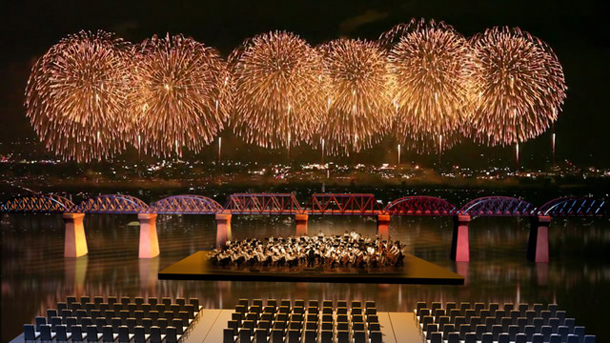I am in the Thai town of Kanchanaburi, approaching the bridge on the river Kwai. It's part of the infamous Thai-Burma Railway constructed by the Japanese through forced labour at the cost of over 100,000 lives. Today it is preserved as a memorial to that war crime. As I walk up to the bridge music is playing -- specifically, "Itsy Bitsy Teeny Weeny Yellow Polka Dot Bikini," by Brian Hyland.
A little off? Or am I just being difficult?
The global tourist industry often seems like a ravenous beast that eats history and culture and shits out Snoopy key chains and cretinous T-shirts. Meanwhile Hollywood has been depicted as a machine that eats history and shits out fairy tales. The Kanchanaburi bridge provides evidence for both propositions. In this case Hollywood even reshaped the facts on the ground. This bridge on the river Kwai was not originally on the river Kwai at all. It was built on a stretch of the Mae Klong River. But author Pierre Boulle's book was called The Bridge on the River Kwai, probably because most of the Thai-Burma Railway was built along the river Thais called Khwae Noi. So after the 1958 Oscar-winning David Lean film made the place a tourist attraction, the stretch of water below the bridge was renamed. Retroactively it is indeed a bridge over the river Kwai.
Not all recent innovations can be blamed on Hollywood. Certainly not the evening disco light show. It's quite pretty -- hot pink and pale yellow, turquoise and green, flashing along the curving spans of the railroad trestle. Watching the show you might assume that the bridge was made famous in a Doris Day-Cary Grant flick called Honeymoon Jungle Train.
Hellfire Pass
If you are going to do disco light shows anywhere on the Death Railway, the famous bridge may be the least inappropriate place. This was not the scene of the worst horrors of the Death Railway. The original version of the bridge -- destroyed more than once by Allied bombs but never by a dying Alec Guinness -- was completed with relatively few deaths, a fact considered a tribute to British Lieutenant Colonel Philip Toosey (whom British prisoners say was nothing like the quasi-collaborating Colonel Nicholson played by Guinness in the film). The real horrors happened further down the line. And it is there that tourists must go to find a fitting tribute to the POWs and Asian conscripts who perished in the thousands building the railway.
The Hellfire Pass Museum opened in 1987, built by the Australian government after a former POW sought out the spot on the old abandoned line where the flickering of torches through the night had led the prisoners to gave it the nickname by which it is once again known. The museum is located about 80 kilometres north of Kanchanaburi. It is a very different kind of place, offering pictorial and factual evidence of the war crimes committed by Japanese overlords conditioned to believe their defeated enemies had forfeited their honour and human dignity by not dying in battle. It's estimated that 13,000 POWs and 90,000 Asian conscripts died in the construction of the Thai-Burma Railway, and the museum features film clips, photographs and art work created by prisoners themselves. From the museum building, a path leads down to the old rail line, now a gravel-covered walk in the heat leading to the places where paths were cut through steep rock at an even steeper human cost.
Hellfire Pass is a deep slash through the rock, now marked with a plaque and black memorial stone. Further along the line is another pass called Hammer and Tap by the prisoners. On the way to Hammer and Tap you pass by the Kwae Noi Lookout, where the valley opens into a wide vista offering a panoramic view of Thai countryside. A website calls it "a great vantage point for all photographers and bird watchers." It would be a great spot for a souvenir stand. There isn't one.
Quiet visitors
Back at the museum I ask a staff member how many Japanese tourists come through. Not many, she answers. But some. "They are quiet. They don't want to talk."
At least they see. It can't be easy, especially since the Japanese nation as a whole has averted its gaze. In a perfect world, Japanese tour buses would line the parking lot. Of course, in a truly perfect world there wouldn't be a Hellfire Pass Museum. Only disco light shows, tasty snacks and happy music, all of which await you back in town. There's a place for everything. ![]()
Read more: Travel
















Tyee Commenting Guidelines
Comments that violate guidelines risk being deleted, and violations may result in a temporary or permanent user ban. Maintain the spirit of good conversation to stay in the discussion.
*Please note The Tyee is not a forum for spreading misinformation about COVID-19, denying its existence or minimizing its risk to public health.
Do:
Do not: